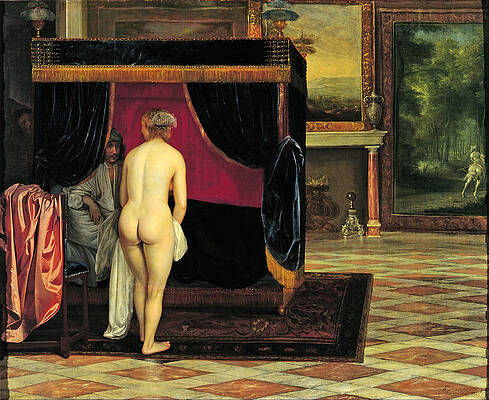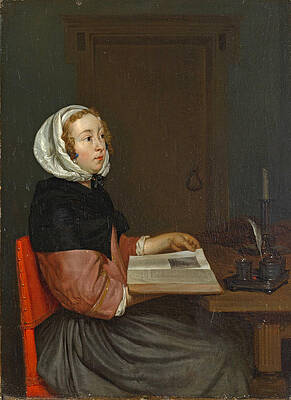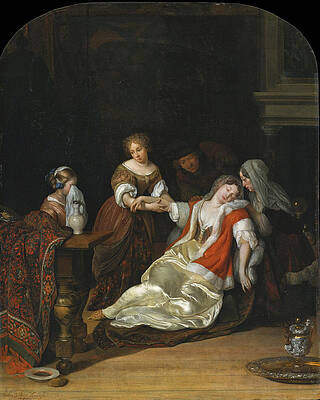Eglon van der Neer
Paintings
Circe Punishes Glaucus by Turning Scylla into a Monster
Kandaules' Wife Discovering the Hiding Gyges
Judith
La Grande Dame
A Lady playing a Lute with a Gentleman seated at a Table in an Interior
The Reader
The Fainting Fit

Elegant Couple in an InteriorLa Grande Dame



Children with a Cage and a Cat








Fine Art Prints | Greeting Cards | Phone Cases | Lifestyle | Face Masks | Men's , Women' Apparel | Home Decor | jigsaw puzzles | Notebooks | Tapestries | ...
Eglon van der Neer (1635/36,[1] – 3 May 1703), was a Dutch painter of historical scenes, portraits and elegant, fashionable people, and later of landscapes.
Life
Van der Neer was born in Amsterdam and was probably first taught by his father, Aert van der Neer, who married in Amsterdam in 1629, coming from Gorinchem. Eglon had a least five brothers and sisters, who were baptized in the Nieuwe Kerk between 1640 and 1650. He took lessons from Jacob van Loo, who was then one of the foremost figure painters in Amsterdam. Around 1654, Van der Neer, who probably had just finished his education with Van Loo, traveled to Orange, Vaucluse in the South of France and entered the service of Friedrich von Dohna (1621–1688), Governor of the Principality of Orange. Van der Neer stayed for three or four years in Orange and returned to Amsterdam by the end of 1658. There he married in February Maria Wagensvelt, the daughter of a wealthy Rotterdam notary. In 1663, Van der Neer and his family moved to Rotterdam, where Adriaen van der Werff became his student. He stayed in Rotterdam until his wife died in 1677. In 1679, he moved to The Hague and in 1680 he became a member of the Confrerie Pictura there.[2] Later that year he moved again, taking up his residence at Brussels, where he married the miniature painter Marie Du Chastel in the following year. She bore him nine children.
Painter for Royalty
In Brussels, Van der Neer established a good relationship with the governor of the Spanish Netherlands, the Marquess of Castanaga. In 1687, Van der Neer was appointed court painter to the Spanish King Charles II of Spain. In 1689, when Carlos' first wife died, Van der Neer portrayed one of the new wedding candidates, Maria Anna of Neuburg. In 1695, Johann Wilhelm, Elector Palatine bought a painting by Van der Neer in Rotterdam, when traveling through the Netherlands. This painting must have pleased him, because shortly thereafter the Elector Palatine contacted Van der Neer directly and gave him commissions. In that same year Brussels was bombarded by French troops and Van der Neer started to look for another place to begin a new life. The Elector Palatine had been looking for a replacement ever since his last court painter Johannes Spilberg had died in 1690. Van der Neer's second wife had died in 1692, and he met Spilberg's daughter, herself a qualified painter, Adriana Spilberg. They married in 1697 and in 1698 Johann Wilhelm offered Van der Neer the position at his court as head painter. Van der Neer thus settled in Düsseldorf, and would remain here for these last years of his life.
Legacy
During his Amsterdam and Rotterdam period, Van der Neer primarily painted genre scenes and portraits that betray a stunning variety of styles.[3] His interior scenes show the influence of Pieter de Hooch, Gerard ter Borch, Gabriel Metsu and Frans van Mieris. Van der Neer painted only a handful of mythological and Biblical scenes.[4] The early examples are very similar to his genre scenes and show figures in contemporary interiors. Later, in Brussels and Düsseldorf, Van der Neer situated his historical scenes outdoor, with a landscape setting. In these paintings he followed the example of Adam Elsheimer. His pure landscapes, without figures from literary sources, show various other stylistic influences, such as Jan Brueghel the Elder, and Jacques d'Arthois. Most of Van der Neer's paintings are small and his style is highly finished. However, he also could work on a large scale and would then adjust his manner of painting.
Notes
Liedtke, W. (2007) Dutch painting in the Metropolitan Museum of Art, p. 512.
RKD entry on Eglon van der Neer
* http://www.wga.hu/frames-e.html?/html/n/neer/eglon/
Judith in the National Gallery by Eglon van der Neer [1]
References
Public Domain This article incorporates text from a publication now in the public domain: Chisholm, Hugh, ed. (1911). Encyclopædia Britannica (11th ed.). Cambridge University Press.
Peter Hecht, De Hollandse fijnschilders: Van Gerard Dou tot Adriaen van der Werff, exhibition catalogue Amsterdam, Rijksmuseum.
Peter Hecht, ‘Een Van der Neer voor het Rijksmuseum’, Kunstschrift 35 (1991), no. 3, pp. 5,6.
Eddy Schavemaker, ‘Copy and paste in the Work of Eglon van der Neer: Some Thoughts on Eclecticism’, in E. Mai (ed.), Holland nach Rembrandt. Zur niederländischen Kunst zwischen 1670 und 1750, Cologne 2006, pp. 247–262.
Eddy Schavemaker, Eglon Hendrik van der Neer (1635/36-1703). Zijn leven en werk, PhD thesis Utrecht University 2009
Eddy Schavemaker, Eglon van der Neer. His Life and Work, Doornspijk 2010
----
Fine Art Prints | Greeting Cards | Phone Cases | Lifestyle | Face Masks | Men's , Women' Apparel | Home Decor | jigsaw puzzles | Notebooks | Tapestries | ...
----
Artist
A - B - C - D - E - F - G - H - I - J - K - L - M -
N - O - P - Q - R - S - T - U - V - W - X - Y - Z
Retrieved from "http://en.wikipedia.org/"
All text is available under the terms of the GNU Free Documentation License










